Elevate access to manage all Azure subscriptions and management groups
As a Global Administrator in Microsoft Entra ID, you might not have access to all subscriptions and management groups in your directory. This article describes the ways that you can elevate your access to all subscriptions and management groups.
Note
For information about viewing or deleting personal data, see General Data Subject Requests for the GDPR, Azure Data Subject Requests for the GDPR, or Windows Data Subject Requests for the GDPR, depending on your specific area and needs. For more information about GDPR, see the GDPR section of the Microsoft Trust Center and the GDPR section of the Service Trust portal.
Why would you need to elevate your access?
If you are a Global Administrator, there might be times when you want to do the following actions:
- Regain access to an Azure subscription or management group when a user has lost access
- Grant another user or yourself access to an Azure subscription or management group
- See all Azure subscriptions or management groups in an organization
- Allow an automation app (such as an invoicing or auditing app) to access all Azure subscriptions or management groups
How does elevated access work?
Microsoft Entra ID and Azure resources are secured independently from one another. That is, Microsoft Entra role assignments do not grant access to Azure resources, and Azure role assignments do not grant access to Microsoft Entra ID. However, if you are a Global Administrator in Microsoft Entra ID, you can assign yourself access to all Azure subscriptions and management groups in your directory. Use this capability if you don't have access to Azure subscription resources, such as virtual machines or storage accounts, and you want to use your Global Administrator privilege to gain access to those resources.
When you elevate your access, you will be assigned the User Access Administrator role in Azure at root scope (/). This allows you to view all resources and assign access in any subscription or management group in the directory. User Access Administrator role assignments can be removed using Azure PowerShell, Azure CLI, or the REST API.
You should remove this elevated access once you have made the changes you need to make at root scope.
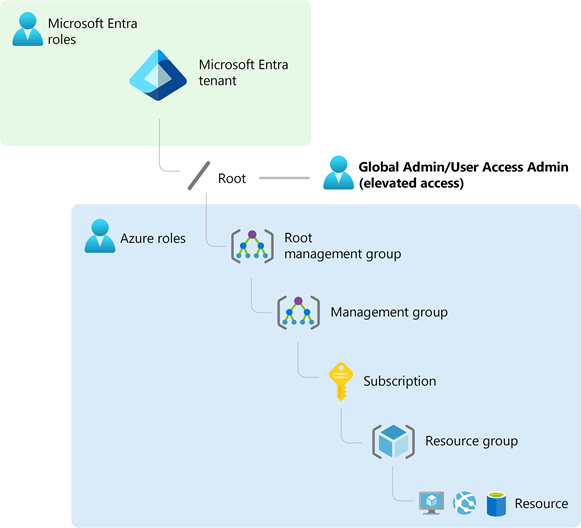
Perform steps at root scope
Step 1: Elevate access for a Global Administrator
Follow these steps to elevate access for a Global Administrator using the Azure portal.
Sign in to the Azure portal as a Global Administrator.
If you are using Microsoft Entra Privileged Identity Management, activate your Global Administrator role assignment.
Open Microsoft Entra ID.
Under Manage, select Properties.
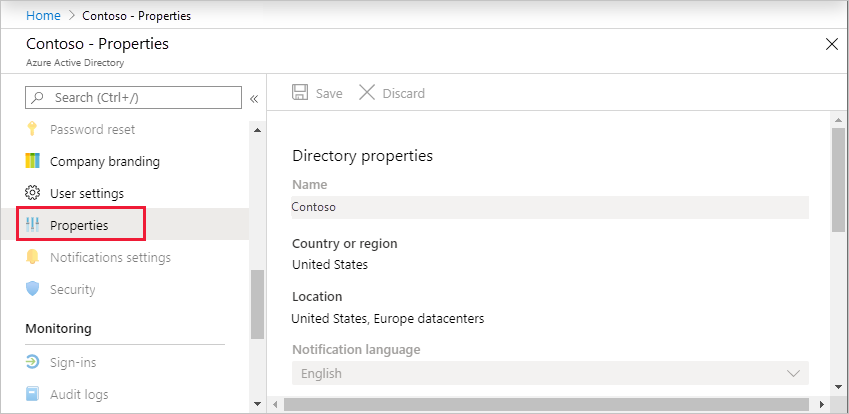
Under Access management for Azure resources, set the toggle to Yes.
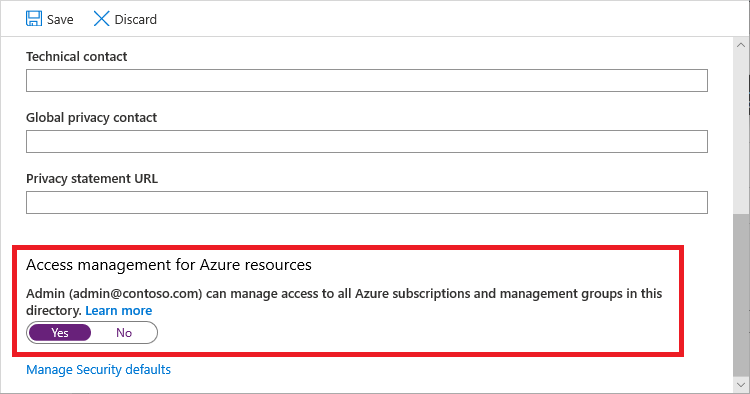
When you set the toggle to Yes, you are assigned the User Access Administrator role in Azure RBAC at root scope (/). This grants you permission to assign roles in all Azure subscriptions and management groups associated with this Microsoft Entra directory. This toggle is only available to users who are assigned the Global Administrator role in Microsoft Entra ID.
When you set the toggle to No, the User Access Administrator role in Azure RBAC is removed from your user account. You can no longer assign roles in all Azure subscriptions and management groups that are associated with this Microsoft Entra directory. You can view and manage only the Azure subscriptions and management groups to which you have been granted access.
Note
If you're using Privileged Identity Management, deactivating your role assignment does not change the Access management for Azure resources toggle to No. To maintain least privileged access, we recommend that you set this toggle to No before you deactivate your role assignment.
Click Save to save your setting.
This setting is not a global property and applies only to the currently signed in user. You can't elevate access for all members of the Global Administrator role.
Sign out and sign back in to refresh your access.
You should now have access to all subscriptions and management groups in your directory. When you view the Access control (IAM) pane, you'll notice that you have been assigned the User Access Administrator role at root scope.
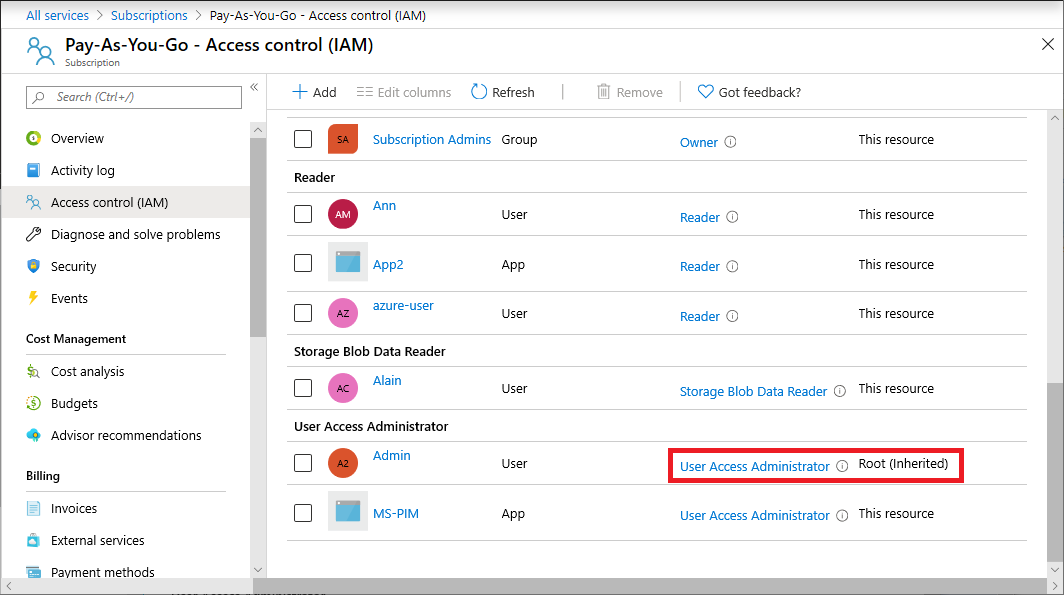
Make the changes you need to make at elevated access.
For information about assigning roles, see Assign Azure roles using the Azure portal. If you are using Privileged Identity Management, see Discover Azure resources to manage or Assign Azure resource roles.
Perform the steps in the following section to remove your elevated access.
Step 2: Remove elevated access
To remove the User Access Administrator role assignment at root scope (/), follow these steps.
Sign in as the same user that was used to elevate access.
In the navigation list, click Microsoft Entra ID and then click Properties.
Set the Access management for Azure resources toggle back to No. Since this is a per-user setting, you must be signed in as the same user as was used to elevate access.
If you try to remove the User Access Administrator role assignment on the Access control (IAM) pane, you'll see the following message. To remove the role assignment, you must set the toggle back to No or use Azure PowerShell, Azure CLI, or the REST API.
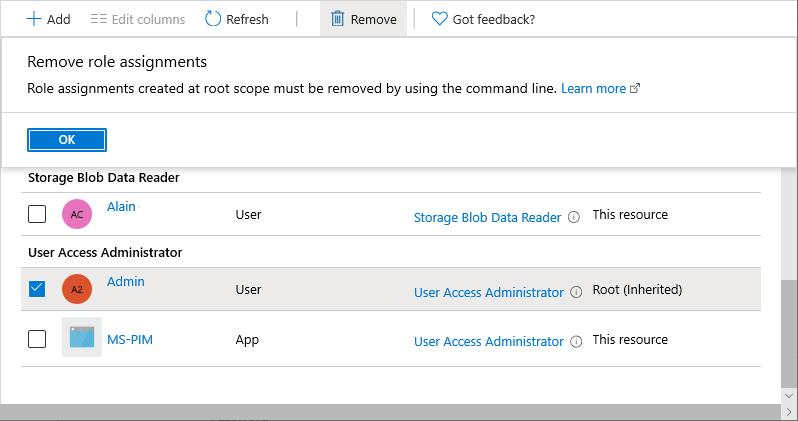
Sign out as Global Administrator.
If you are using Privileged Identity Management, deactivate your Global Administrator role assignment.
Note
If you're using Privileged Identity Management, deactivating your role assignment does not change the Access management for Azure resources toggle to No. To maintain least privileged access, we recommend that you set this toggle to No before you deactivate your role assignment.
View elevate access log entries in the Directory Activity logs
When access is elevated, an entry is added to the logs. As a Global Administrator in Microsoft Entra ID, you might want to check when access was elevated and who did it. Elevate access log entries do not appear in the standard activity logs, but instead appear in the Directory Activity logs. This section describes different ways that you can view the elevate access log entries.
View elevate access log entries using the Azure portal
Sign in to the Azure portal as a Global Administrator.
Open Monitor > Activity log.
Change the Activity list to Directory Activity.
Search for the following operation, which signifies the elevate access action.
Assigns the caller to User Access Administrator role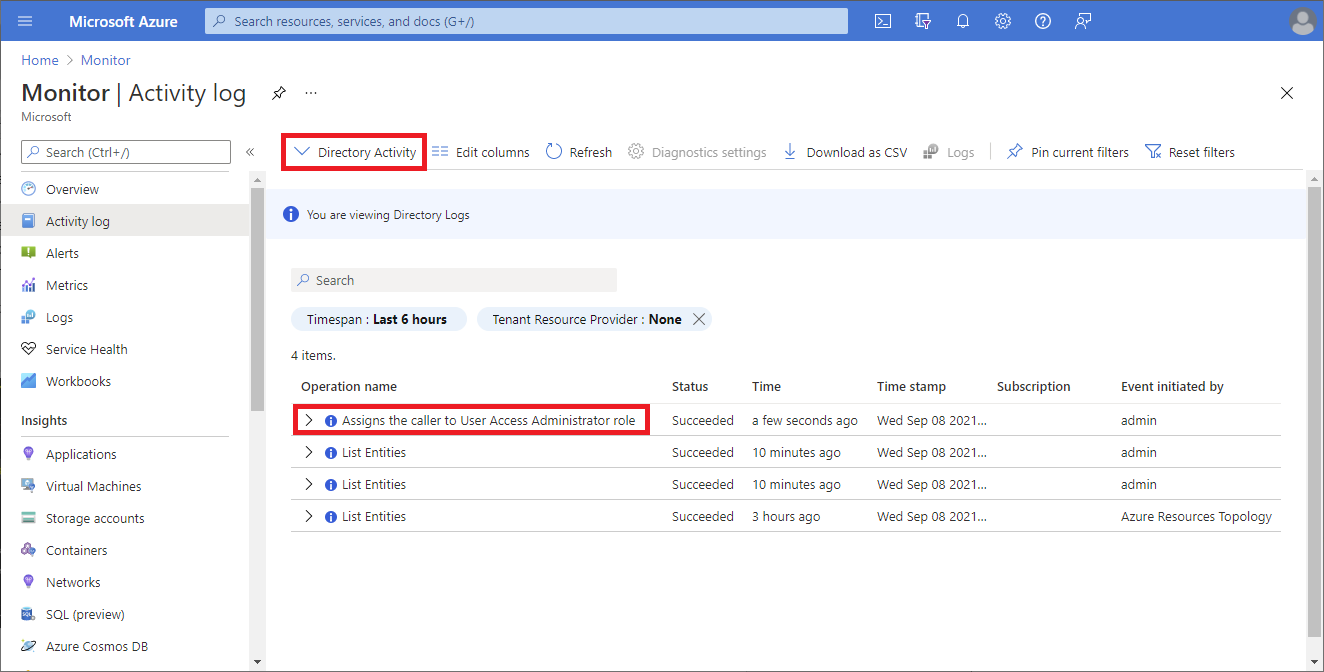
View elevate access log entries using Azure CLI
Use the az login command to sign in as Global Administrator.
Use the az rest command to make the following call where you will have to filter by a date as shown with the example timestamp and specify a filename where you want the logs to be stored.
The
urlcalls an API to retrieve the logs in Microsoft.Insights. The output will be saved to your file.az rest --url "https://management.azure.com/providers/Microsoft.Insights/eventtypes/management/values?api-version=2015-04-01&$filter=eventTimestamp ge '2021-09-10T20:00:00Z'" > output.txtIn the output file, search for
elevateAccess.The log will resemble the following where you can see the timestamp of when the action occurred and who called it.
"submissionTimestamp": "2021-08-27T15:42:00.1527942Z", "subscriptionId": "", "tenantId": "33333333-3333-3333-3333-333333333333" }, { "authorization": { "action": "Microsoft.Authorization/elevateAccess/action", "scope": "/providers/Microsoft.Authorization" }, "caller": "user@example.com", "category": { "localizedValue": "Administrative", "value": "Administrative" },
Delegate access to a group to view elevate access log entries using Azure CLI
If you want to be able to periodically get the elevate access log entries, you can delegate access to a group and then use Azure CLI.
Open Microsoft Entra ID > Groups.
Create a new security group and note the group object ID.
Use the az login command to sign in as Global Administrator.
Use the az role assignment create command to assign the Reader role to the group who can only read logs at the directory level, which are found at
Microsoft/Insights.az role assignment create --assignee "{groupId}" --role "Reader" --scope "/providers/Microsoft.Insights"Add a user who will read logs to the previously created group.
A user in the group can now periodically run the az rest command to view elevate access log entries.
az rest --url "https://management.azure.com/providers/Microsoft.Insights/eventtypes/management/values?api-version=2015-04-01&$filter=eventTimestamp ge '2021-09-10T20:00:00Z'" > output.txt